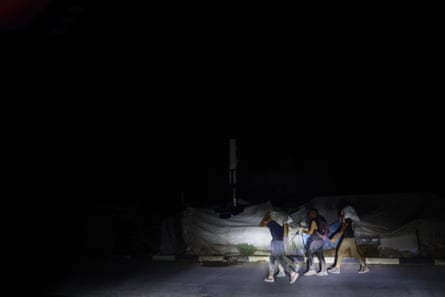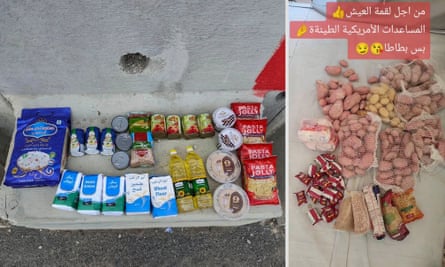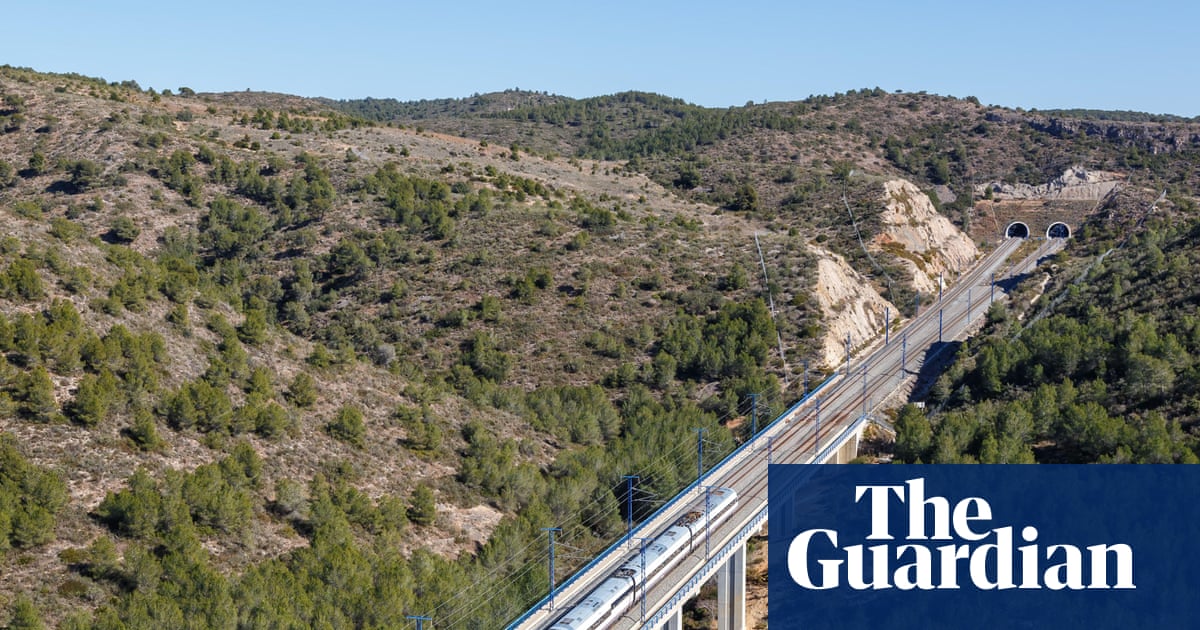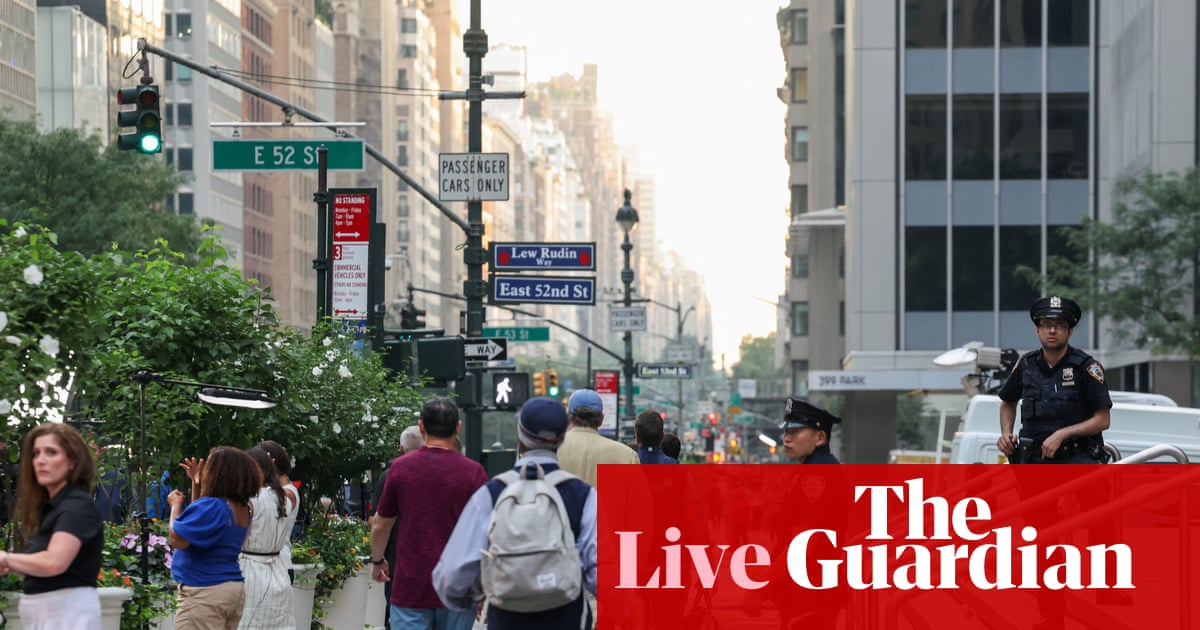Raed Jamal sends the message shortly after he returns, empty-handed, from an aid distribution point to his tent in the al-Mawasi displacement camp in south-west Gaza. “The tanks came and started firing. Three boys near me were martyred,” says the 36-year-old, who has four children. “I didn’t even get anything, just two empty boxes.”
Jamal’s journey involved a long walk to and from a former residential neighbourhood bulldozed by Israeli forces and turned into one of four militarised aid distribution centres run by the Gaza Humanitarian Foundation (GHF), which is based in Delaware in the US.
The GHF sites – Tal al-Sultan, Saudi neighbourhood, Khan Younis and Wadi Gaza – are located in evacuation zones, which means civilians seeking food have to enter areas they have been ordered to leave. According to GHF’s Facebook page, the sites remain open for as little as eight minutes at a time, and in June the average for the Saudi site was 11 minutes. These factors have led to accusations from NGOs that the system is dangerous by design. The Unrwa chief, Philippe Lazzarini, has said “the so-called mechanism … is a death trap costing more lives than it saves.”
The system favours the strongest, so it is mostly men who travel along the designated routes. Then they wait – often for hours – for a centre to open. Finally, there is a dash into the centre of the zones and a scramble to grab a box.
At every stage, those seeking aid pass Israeli tanks and troops, as quadcopters fly above. In another clip shared by Jamal he ducks as bullets pass overhead.
“We have purged our hearts of fear,” Jamal says of his near daily walks to the site. “I need to bring food for my children so they don’t die of hunger.”
A new system, and near daily deaths
GHF, a startup organisation with no experience of distributing food in complex conflict zones, employs US mercenaries at the sites, which opened in May. They replaced 400 non-militarised aid points run under a UN system that Israel claimed had to be shut down because Hamas was diverting aid from it. No evidence for this has been provided.
Since May, more than 1,000 people have died while seeking food from the centres and other humanitarian convoys, according to the UN.
The sites’ opening times are usually announced in posts on a Facebook account and, more recently, messages sent through a Telegram channel. A WhatsApp channel was also set up in the first weeks. People have been warned not to approach the centres until they open.
As the chart below shows, for the site Jamal visited, the amount of time between the site’s opening time being announced and the opening itself decreased dramatically in June.
Mahmoud Alareer, a 27-year-old living in a tent in western Gaza City, says the opening time announcements for the aid site he uses – Wadi Gaza – have become useless, because of the distance from where he is living. Instead, he travels to the edges of the site in the middle of the night and gambles on it opening at 2am, as it has on every visit so far.
First he climbs on to the back of a truck for the long ride south from Gaza City through the militarised Netzarim corridor. Then he waits in the dark until Israeli forces allow him to enter. “You get there and you slowly, slowly advance,” he says. “You always know that it could be you who gets shot, or it might be someone next to you.”
Alareer says chaos always ensues when the aid point opens, as people start running towards the packages, which are left in the middle of the distribution zone. People trip over craters and tangled wires.

GHF has faced severe criticism from the humanitarian community due to the dangers posed to Palestinians both at the sites and on the roads around them. In early July, more than 170 NGOs called for GHF to be shut down, accusing it of violating the principles of humanitarian aid, and calling for the resumption of non-militarised aid in Gaza.
Médecins Sans Frontières’ (MSF) emergency coordinator in Gaza, Aitor Zabalgogeazkoa, says night-time distributions are particularly dangerous because so many roads in southern Gaza have been made unrecognisable by Israeli bombing, making it hard for Palestinians to stick to routes designated by GHF.
Zabalgogeazkoa is scathing about the GHF system. “This is not humanitarian aid,” he says. “We can only think that it was designed to cause damage to the people seeking aid.”
GHF and the IDF have been approached for comment.
GHF has previously said the UN figures for deaths around distribution sites are “false and misleading”. It has also defended its operations more generally and accused its critics of engaging in a “turf war” over humanitarian supplies. It says it bears no responsibility for deaths outside the perimeters of its sites.
The Israeli military has previously acknowledged firing warning shots at Palestinians who it says have approached its forces in a suspicious manner. It has also disputed some of the death tolls provided by the Palestinian authorities.
Palestinians’ unmet aid needs
GHF runs only four sites to feed 2 million people, in a territory where extreme hunger is widespread and food security experts have warned of looming famine.
It says it has delivered more than 85 million meals “via roughly 1,422,712 boxes” since its operations began. According to these figures, each box would provide a family with about 60 meals. The organisation has posted photos of GHF-marked boxes that have items such as flour, potatoes, beans and oil. However, Palestinians in Gaza have shared pictures showing open boxes at GHF sites containing a smaller range of items.

Olga Cherevko, a spokesperson for the UN Office for the Coordination of Humanitarian Affairs, says she could not comment on the specific logistics of GHF, but that aid should go beyond food and should include water, cooking gas or other cooking facilities. “If you look at Gaza now … people have been deprived of everything that sustains life: shelter materials, fuel, cooking gas, hygiene materials, everything that one needs to feel dignified, to have some sort of semblance of normality,” she says.
According to the World Food Programme (WFP), nearly a third of Gaza’s population is going several days without food, and 470,000 people are expected to face the most severe levels of hunger between May and September this year.
The WFP has also warned that dietary diversity declined sharply in May and continued to worsen in June.
Damage to farmland over the course of the war has only increased Palestinians’ reliance on aid. A study published this year using satellite imagery to assess damage to farmland found up to 70% of tree crops had been damaged.
A Unosat assessment from April found that 71.2% of Gaza’s greenhouses had been damaged. This sequence shows damage to greenhouses and orchards in Beit Lahiya.
In late March, dozens of bakeries supported by the WFP halted production due to the Israeli blockade. A handful briefly resumed bread production in May when some trucks were allowed into the territory, as this timeline shows.
Jamal reiterates that he has no choice but to return to his nearest GHF site, despite the dangers. “I have gone four days in a row and not brought anything back, not even flour – nothing,” he says. “Sometimes you just can’t beat the others. But what else can we do, our life is a struggle.”

 3 months ago
129
3 months ago
129

















































